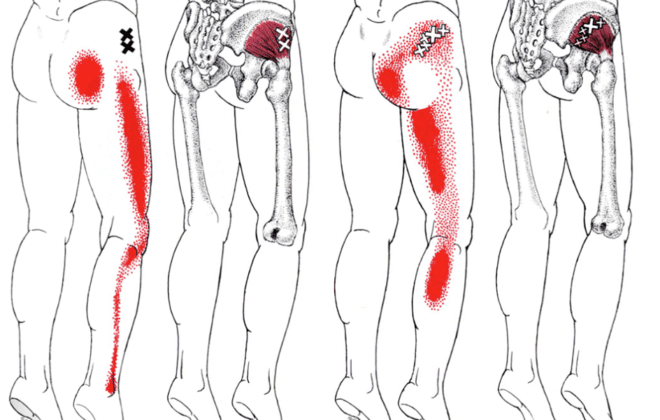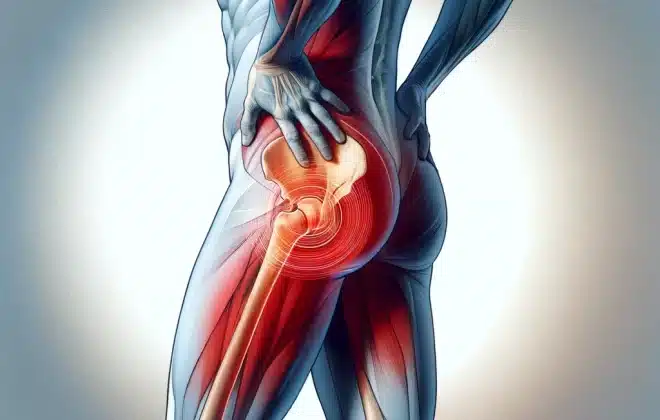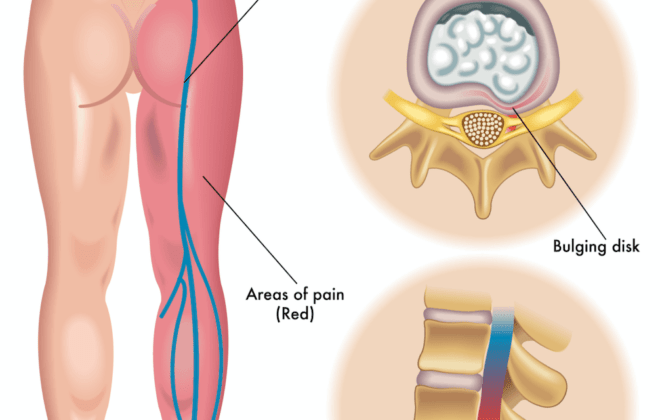Glute Medius Trigger Points | How To Locate And Self-Treat
Ever had that annoying aching pain in your upper hip region? It often shows up while sitting, standing, or while driving.
One of the most common causes is glute medius trigger points. This powerful muscle is located deep to the big boss gluteus maximus next to the undercover agent, gluteus minimus.
In this article we’ll cover where this muscle is located, its action, and how to address active trigger points.
Muscle Anatomy: Gluteus Medius
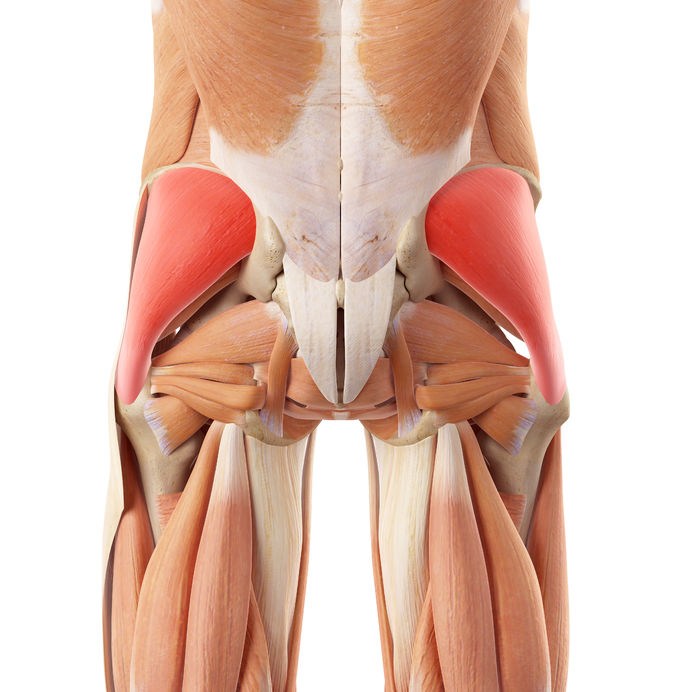
The gluteus medius is the unsung hero of the pelvis. Think of it as the stabilizing force every time you swing a leg forward or balance on one leg while doing those cool dance moves.
Its fan-shaped structure is divided into anterior (front) and posterior (back) sections. Key landmarks for this muscle include the ilium, sacrum, femur, and hip joint.
When this muscle contracts, it functions as a hip abductor. The anterior fibers of assist with medial rotation of the hip, while the posterior fibers contribute to laterally rotate the hip.
When this muscle is having difficulty, the pelvis will drop down on the same side (called a Trendelenberg), and raising the leg out to the side is difficult to do.
Why Should You Care About Glute Medius Trigger Points?
If you’ve got active trigger points in the glute medius, you might find yourself complaining about pain in the sacral, gluteal, and SI joint areas. It is often associated to low back pain as well.
This pain often shows up while walking, and it might even keep you tossing and turning if you try sleeping on the affected side.
Causes Of Glute Medius Trigger Points Include:
– That beach run you took in the sand.
– Standing on one foot for way too long while standing in line.
– Sports injuries, or sudden falls.
– Actual SI joint dysfunction or even sitting on your wallet (yes, seriously!).
– And hey, remember the quadratus lumborum muscle? Its trigger points often gang up with the glute medius ones.
It’s essential to note that the gluteus medius trigger points can be sneaky. They’re often mistaken for sciatica, SI joint dysfunction, or trochanteric bursitis.
Locating & Self-Treating Glute Medius Trigger Points
In order to release trigger points, you first need to identify them. There is a considerable amount of debate on exactly what a trigger point is, but the most common ID is a tender spot that refers sensation/ache to an area other than what is being pressed on.
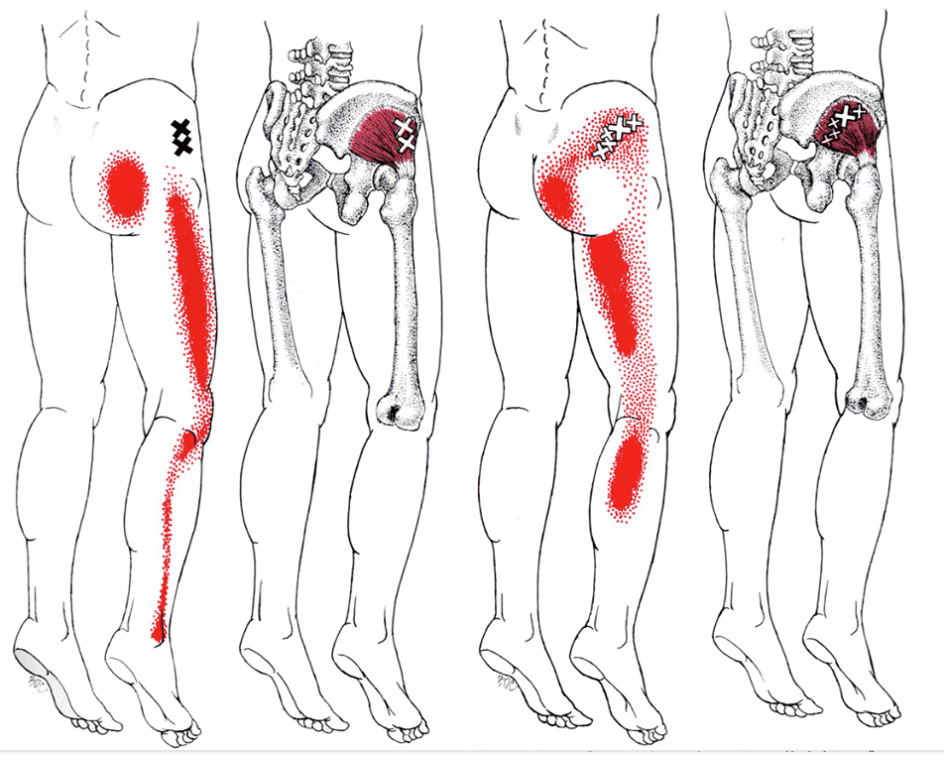
1. Medial Gluteus Medius Trigger Point: Start by locating the PSIs, which feels like a bony prominence. The trigger point is about an inch outside and below it. To release, use a thumb-over-thumb technique, moving the skin over the trigger point, and press down on it for 30-45 seconds. Repeat 2-3 more times.
2. Middle Gluteus Medius Trigger Point: This one’s just to the side of the medial trigger point, beneath the highest point of the iliac crest. Compress it with your thumb or Theracane for 30-45 seconds. Repeat 2-3 more times.
3. Lateral Gluteus Medius Trigger Point: This one’s a rare breed but worth checking. It’s further out from the middle point and directs pain to the sacral area. If found, treat it with the techniques above.
When you are finished with treating the individual trigger points, stretch the glutes with an exercise such as the 90-90, or cross-knee glute stretch. 2-3 repetitions, holding for 30 seconds each will get the job done. Additionally, while in the area, you might as well hit the glute minimus trigger points.
Don’t forget to add exercises for the glute medius to restore function! Learn more about the best glute medius exercises here.
In Summary:
Understanding and treating the glute medius trigger points can be a game-changer for anyone suffering from low back or hip pain.
Remember to always use moderate pressure at most (4/10 intensity max) always take a comprehensive approach to resolving pain issues.
Don’t ONLY rely on trigger point therapy. Evaluating your hip flexors, gluteus maximus muscle function, sacroiliac joint, and other adjacent regions is crucial for getting long term results with buttock region pain.
Sam Visnic
Most Popular Posts
Categories
- Deep Gluteal Pain Syndrome (8)
- Deltoids (2)
- Foam Rolling (2)
- Glutes (9)
- Hamstrings (5)
- Hypnosis for Pain (3)
- Lats (2)
- Levator Scapulae (4)
- Lifestyle (8)
- Massage Therapy (39)
- Mobility (21)
- Movement and Exercise (19)
- Muscles (22)
- Nutrition (2)
- Obliques (1)
- Pain (25)
- Pectorals (3)
- Piriformis (3)
- Plantar Fasciitis (11)
- Psoas (11)
- Quadratus Lumborum (3)
- Quadriceps (2)
- Rhomboids (3)
- Sciatica (1)
- Serratus Anterior (1)
- SI Joint (14)
- Sternocleidomastoid (1)
- Stretching (18)
- Subscapularis (1)
- TMJ (2)
- Trapezius (1)
- Uncategorized (12)

